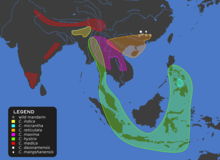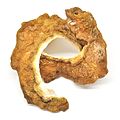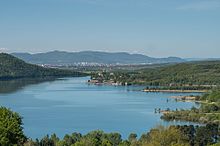카피르 라임
Kaffir lime| 카피르 라임 | |
|---|---|
 | |
| 나무 위의 과일 | |
| 과학적 분류 | |
| 킹덤: | 플랜태 |
| 클래드: | 기관지동물 |
| 클래드: | 안기오스페름스 |
| 클래드: | 에우디코츠 |
| 클래드: | 로시즈 |
| 순서: | 사핀다목 |
| 패밀리: | 루타과 |
| 속: | 감귤류 |
| 종: | C. 히스트릭스 |
| 이항식 이름 | |
| 시트러스 히스트릭스 | |
 | |
| C. Hystrix가 옅은 녹색으로[2] 표시된 주요 시트러스 재배지의 원래 야생 범위 지도 | |
| 동의어[3] | |
| |
카피르 라임, 막크루트 라임[4](미국: /ˈmækrət/, 영국: /məkˈruːt/), 타이 라임 또는 모리셔스 파페다(Mauritius papeda)로 불리는 감귤류 히스트릭스는 동남아시아와 중국 남부가 원산지인 감귤류 과일이다.[5][6][7]
그것의 과일과 잎은 동남아시아 요리에 사용되고 그것의 필수 기름은 향기에 사용된다.[8] 그것의 껍질과 찌그러진 잎은 강렬한 감귤 향기를 내뿜는다.
이름

'카피르'는 석회에 적용하게 된 메커니즘은 불확실하지만 결국 이교를 뜻하는 아랍어 카피르에서 유래한 것으로 생각된다. 스와힐리 해안을 점령한 후 무슬림들은 15, 16세기에 최고조에 달했던 인도양 노예 무역을 위해 점점 더 많이 납치된 비 이슬람 원주민 아프리카인들을 지칭하기 위해 이 용어를 사용했다.[citation needed]
가장 유력한 어원은 스리랑카의 한 민족 집단인 카피르족을 통해서일 것이다.[9] The earliest known reference, under the alternative spelling "caffre" is in 1888 book The Cultivated Oranges, Lemons Etc. of India and Ceylon by Emanuel Bonavia, who notes, "The plantation coolies also smear it over their feet and legs, to keep off land leeches; and therefore in Ceylon [Sri Lanka] it has got also the name of Kudalu dchi, or Leech 라임. 유럽 사람들은 카프레 라임이라고 불러."[9][10] 비슷하게, H.F. 맥밀런의 1910년 책 "열대 정원 가꾸기와 식재에 관한 안내서" "실론의 '카피르 라임'"도 있다.[9][11]
또 다른 제안 어원은 인도 이슬람교도들이 "다른 것과 이국적인 증명"을 위해 동쪽의 비무슬림 땅에서 수입한 과일을 직접 수입하는 것이다.[9] 과일의 이름이 직접 남아프리카 민족 슬루어 '카피르(kaffir)'에서 유래했다는 주장(아래 '이름' 참조)은 잘 뒷받침되지 않는다.[9]
C. Hystrix는 고유 영역에서 다양한 이름으로 알려져 있다.
- 인도네시아어로 제륵 푸르륵, 말레이어로 리마우 푸르륵. 푸루트(Purut)는 과일의 울퉁불퉁한 질감을 가리킨다.[12]
- 중국어로 된 젠옌젠( ji箭橙)
- 필리핀의 카부요 또는 쿨루봇.[13] 라구나에 있는 카부야오 시는 열매의 이름을 따서 명명되었다.[14]
- 태국의 막루드 또는 막루트(Makrud 또는 makrut, /maʔ.krùːt/) (Bergamot orange에도 이름이 사용된다.
- 막키 오두막(ໝາກຂີໝາກຂີຫູດ, /ma᷆kk).라오스의 Kʰi᷆ː.hu᷆ːt/)
- 베트남에서 truc 또는 chanh sac.[6][15]
- 레유니온 섬의 콤바바
키 라임이나 페르시아 라임과 같이 여러 잡종 라임의 조상이 되는 필리핀 고유의 비슷한 감귤류 과일인 미크란타는 C. 히스트릭스와 같은 종을 나타낼 수도 있지만 카피르 라임의 게놈적 특성화는 확정적인 결론을 내릴 수 있을 만큼 충분히 상세하게 수행되지 않았다.[16]
이름
남아프리카에서 아랍어 카피르는 백인 식민주의자들에 의해 흑인 아프리카인들을 위한 민족적 비방인 "[9]카피르"로 채택되었다.[17] 따라서 일부 저자들은 "카피르 라임"에서 덜 알려진 이름인 "막루트 라임"으로 바꾸는 것을 선호하지만, 남아프리카에서는 보통 "타이 라임"[18][19][20]이라고 부른다.
설명
C. Hystrix는 가시덤불이며, 높이가 2~11m(6~35ft)이며, 방향성이 있고 뚜렷한 모양의 "이중" 잎이 있다.[21][22] 이 모래시계 모양의 잎은 잎날개에 납작하고 잎처럼 생긴 줄기를 더한다. 열매는 거칠고 초록색이며 노란색으로 익는다. 겉은 울퉁불퉁하고 넓이는 약 4cm(2인치)로 작은 것으로 구별된다.[22]
역사
피에르 소네랏 (1748년-1814년)은 1771년-72년에 그것의 표본을 수집했고, 그것은 라마크의 백과사전 메토디크 (1796)에 등장한다.[23][24]
카피르 라임은 1868년 실론에서 카피르 라임이라는 이름으로 텍스트에 등장하는데, 실론에서는 주스를 다리에 문지르고 양말을 신으면 거머리 물리지[25] 않는다. 이것은 거머리 라임이라는 이름의 유래가 될 수 있다.
사용하다
요리.
C. 히스트릭스 잎은 인도네시아, 라오스, 캄보디아, 태국과 같은 동남아시아 음식에서 사용된다.[citation needed] 잎은 식물의 가장 많이 사용되는 부분으로 신선하거나 건조하거나 냉동되어 있다. 잎은 태국어[26][27](tom yum과 같은 요리의 경우)와 캄보디아 요리(기본 페이스트 "krueng"[28]의 경우)에서 널리 사용된다. 잎은 베트남 요리에 닭요리에 향기를 더하고 달팽이를 쪄낼 때 톡 쏘는 냄새를 줄이는 데 쓰인다. 잎은 소토 아얌과 같은 음식에는 인도네시아 요리(특히 발리 요리, 자바 요리)에 사용되며, 닭고기와 생선류에는 인도네시아 만엽과 함께 사용된다. 그들은 말레이시아와 버마 요리에서도 발견된다.[29]
라오스 카레 페이스트와 태국 카레 페이스트에서 흔히 사용되는 껍질(피)은 향기롭고 아스트링한 맛을 더한다.[26] 이 과일의 제스트인 콤바바는 크리올 요리에 사용되어 모리셔스, 레유니온, 마다가스카르의 럼과 루게일에 풍미를 부여한다.[citation needed][30] 캄보디아에서는 과일 전체가 결정화/먹기 위한 것이다.[31]
약용
껍질의 주스와 껍질은 일부 아시아 국가에서는 전통의학에서 사용된다; 과일의 주스는 종종 샴푸에 사용되며 머리 이아를 죽이는 것으로 여겨진다.[22]
기타 용도
이 주스는 태국에서[27], 그리고 캄보디아에서 아주 가끔 옷과 털을 위한 클렌저로 사용된다. 과일 조각과 혼합된 향수는 캄보디아의 종교 의식에서 사용된다.
카피르 석회유는 많은 분야에서 원료로 사용되고 있는데, 그 중에는 제약, 농약, 식품, 위생, 화장품, 향수 산업 등이 있다. 아로마 테라피에도 광범위하게 사용되며 각종 화장품과 미용 제품의 필수 성분으로도 쓰인다.[32]
재배
C. Hystrix는 가정 과일 생산을 위한 정원 관목으로 적합한 기후에서 전세계적으로 재배된다. 그것은 컨테이너 정원과 파티오, 테라스, 그리고 음악원에 있는 큰 정원 화분에 매우 적합하다.
주요 성분
특성 향기를 담당하는 화합물은 (--(S)-시토넬로 확인되었으며, 잎 기름에 80%까지 포함되어 있다. 소량 성분에는 시트로넬롤(10%), 네롤 및 리모넨이 포함된다.
입체화학적인 관점에서 보면 카피르 석회 잎은 시트로넬의 (S) 입체체만 함유하고 있는 반면, 그 에나토머인 (+-(R)-시트로넬은 레몬밤과 (낮은 정도까지) 레몬잔디에서 모두 발견되지만, (그러나 시트로넬은 후자의 필수유에 있는 미량 성분일 뿐이다.)
카피르 라임 과일 껍질에는 라임 과일 껍질 기름에 필적하는 에센셜 오일이 들어 있는데, 그 주요 성분은 리모넨과 β-피넨이다.[8][33]
독성
C. Hystrix는 껍질과 펄프 양쪽에 상당한 양의 후라노쿠마린을 함유하고 있다.[34] 후라노쿠마린은 잠재적으로 심각한 피부염인 식물성 호토오토더마티염을 유발하는 것으로 알려져 있다.[35] C. 히스트릭스에 의해 유발된 식물성 호토오토더마티염의 한 사례가 보고되었다.[36]
참고 항목
| 위키미디어 커먼스는 시트러스 히스트릭스와 관련된 미디어를 보유하고 있다. |
- 감귤 분류법 – 감귤류 속 식물 분류법
참조
- ^ "TPL, treatment of Citrus hystrix DC". The Plant List; Version 1. (published on the internet). Royal Botanic Gardens, Kew and the Missouri Botanical Garden. 2010. Retrieved March 9, 2013.
- ^ Fuller, Dorian Q.; Castillo, Cristina; Kingwell-Banham, Eleanor; Qin, Ling; Weisskopf, Alison (2017). "Charred pomelo peel, historical linguistics and other tree crops: approaches to framing the historical context of early Citrus cultivation in East, South and Southeast Asia". In Zech-Matterne, Véronique; Fiorentino, Girolamo (eds.). AGRUMED: Archaeology and history of citrus fruit in the Mediterranean. Publications du Centre Jean Bérard. pp. 29–48. doi:10.4000/books.pcjb.2107. ISBN 9782918887775.
- ^ The Plant List: A Working List of All Plant Species, retrieved 3 October 2015
- ^ D.J. Mabberley (1997), "A classification for edible Citrus (Rutaceae)", Telopea, 7 (2): 167–172, doi:10.7751/telopea19971007
- ^ "Citrus hystrix". Germplasm Resources Information Network (GRIN). Agricultural Research Service (ARS), United States Department of Agriculture (USDA). Retrieved December 7, 2014.
- ^ Jump up to: a b "Citrus hystrix". Flora & Fauna Web. National Parks Singapore, Singapore Government. Retrieved 13 August 2018.[데드링크]
- ^ "Citrus hystrix". Plant Finder. Missouri Botanical Garden. Retrieved 13 August 2018.
- ^ Jump up to: a b Ng, D.S.H.; Rose, L.C.; Suhaimi, H.; Mohamad, H.; Rozaini, M.Z.H.; Taib, M. (2011). "Preliminary evaluation on the antibacterial activities of Citrus hystrix oil emulsions stabilized by TWEEN 80 and SPAN 80" (PDF). International Journal of Pharmacy and Pharmaceutical Sciences. 3 (Suppl. 2).
- ^ Jump up to: a b c d e f Anderson, L. V. (3 July 2014). "Is the Name Kaffir Lime Racist? Why You May Want to Think Twice About Using That Term". Slate Magazine. Retrieved 1 May 2021.
- ^ Macmillan, Hugh Fraser (1910). A handbook of tropical gardening and planting with special reference to Ceylon. Colombo, Ceylon: H. W. Cave & Co. p. 157.
- ^ pann (2019-04-07). "Apa itu purut?". Glosarium Online (in Indonesian). Retrieved 2020-09-02.
- ^ CRC World Dictionary of Medicinal and Poisonous Plants: Common Names, Scientific Names, Eponyms, Synonyms, and Etymology. M-Q. CRC Press/Taylor & Francis. 2012-01-01. ISBN 9781439895702.
- ^ CRC World Dictionary of Medicinal and Poisonous Plants: Common Names, Scientific Names, Eponyms, Synonyms, and Etymology. M-Q. CRC Press/Taylor & Francis. 2012-01-01. ISBN 9781439895702.
- ^ Katzer, Gernot. "Kaffir Lime (Citrus hystrix DC.)". Gernot Katzer's Spice Pages. Retrieved 13 August 2018.
- ^ Ollitrault, Patrick; Curk, Franck; Krueger, Robert (2020). "Citrus taxonomy". In Talon, Manuel; Caruso, Marco; Gmitter, Fred G, Jr. (eds.). The Citrus Genus. Elsevier. pp. 57–81. doi:10.1016/B978-0-12-812163-4.00004-8. ISBN 9780128121634.
- ^ 베로니카 빈제: "카피르 라임"을 말하는 것은 '라임' 전에 N단어를 말하는 것과 같다 - 베로니카 빈제, 2014년 6월 23일, Straight.com
- ^ McKenna, Maryn (2014-07-18), "A Food Has a Historic, Objectionable Name. Should We Change It?", National Geographic, retrieved 12 December 2015
- ^ 공동 석회명은 2014년 7월 8일 CBC 뉴스 칼릴 아크타르에 의해 인종차별주의 역사를 가지고 있다.
- ^ "Kaf·fir also kaf·fir". American Heritage Dictionary. Retrieved 18 September 2017.
- ^ Kumar, Kuntal (1 January 2008). The Original Organics Cookbook: recipes for healthy living. TERI Press. p. 54. ISBN 978-81-7993-155-4.
- ^ Jump up to: a b c Staples, George; Kristiansen, Michael S. (1 January 1999). Ethnic Culinary Herbs: A Guide to Identification and Cultivation in Hawai'i. University of Hawaii Press. pp. 27–29. ISBN 978-0-8248-2094-7.
- ^ https://www.nparks.gov.sg/sbg/research/publications/gardens-bulletin-singapore/-/media/sbg/gardens-bulletin/4-4-54-2-04-y2002-v54p2-gbs-pg-185.pdf
- ^ Bonavia, Emanuel (1888–90). The cultivated oranges and lemons, etc. of India and Ceylon, with researches into their origin and the derivation of their names, and other useful information. With and atlas of illustrations. London: W. H. Allen. p. 309. Retrieved 31 May 2021.CS1 maint: 날짜 형식(링크)
- ^ Henderson, John (capt. 78th Highlanders.) (1868). Skeet, Ch. J. (ed.). The History of the Rebellion in Ceylon During Lord Torrington's Government: Affording a Comparison with Jamaica and Governor Eyre. University of Minnesota. p. 58. Retrieved 31 May 2021.
- ^ Jump up to: a b Loha-unchit, Kasma. "Kaffir Lime –Magrood". Retrieved December 7, 2014.
- ^ Jump up to: a b Sukphisit, Suthon (12 November 2017). "Clean up in kitchen with versatile fruit". Bangkok Post. Retrieved 13 November 2017.
- ^ "What to Replace Kaffir Lime Leaves With". Village Bakery. 2018-12-17. Retrieved 2018-12-19.
- ^ Wendy Hutton, Wendy; Cassio, Alberto (2003). Handy Pocket Guide to Asian Herbs & Spices. Singapore: Periplus Editions. p. 40. ISBN 978-0-7946-0190-4.
- ^ "Mauritian rum has a distinct character to it: Sweeter and smoother". The Economic Times. 2015-03-22.
- ^ Dy Fon Pauline, 2000년 캄보디아에서 사용된 식물들, 임프레레 올림픽 출판사 프놈펜
- ^ Suresh, Anuja; Velusamy, Sangeetha; Ayyasamy, Sudha; Rathinasamy, Menaha (2021). "Techniques for essential oil extraction from kaffir lime and its application in health care products—A review". Flavour and Fragrance Journal. 36: 5–21. doi:10.1002/ffj.3626.
- ^ Kasuan, Nurhani (2013). "Extraction of Citrus hystrix D.C. (Kaffir Lime) Essential Oil Using Automated Steam Distillation Process: Analysis of Volatile Compounds" (PDF). Malaysian Journal of Analytical Sciences. 17 (3): 359–369.
- ^ Dugrand-Judek, Audray; Olry, Alexandre; Hehn, Alain; Costantino, Gilles; Ollitrault, Patrick; Froelicher, Yann; Bourgaud, Frédéric (November 2015). "The Distribution of Coumarins and Furanocoumarins in Citrus Species Closely Matches Citrus Phylogeny and Reflects the Organization of Biosynthetic Pathways". PLOS ONE. 10 (11): e0142757. Bibcode:2015PLoSO..1042757D. doi:10.1371/journal.pone.0142757. PMC 4641707. PMID 26558757.
- ^ McGovern, Thomas W.; Barkley, Theodore M. (2000). "Botanical Dermatology". The Electronic Textbook of Dermatology. Internet Dermatology Society. 37 (5). Section Phytophotodermatitis. doi:10.1046/j.1365-4362.1998.00385.x. PMID 9620476. S2CID 221810453. Retrieved November 29, 2018.
- ^ Koh, D.; Ong, C. N. (April 1999). "Phytophotodermatitis due to the application of Citrus hystrix as a folk remedy". Br J Dermatol. 140 (4): 737–738. doi:10.1046/j.1365-2133.1999.02782.x. PMID 10233333. S2CID 45603195.








